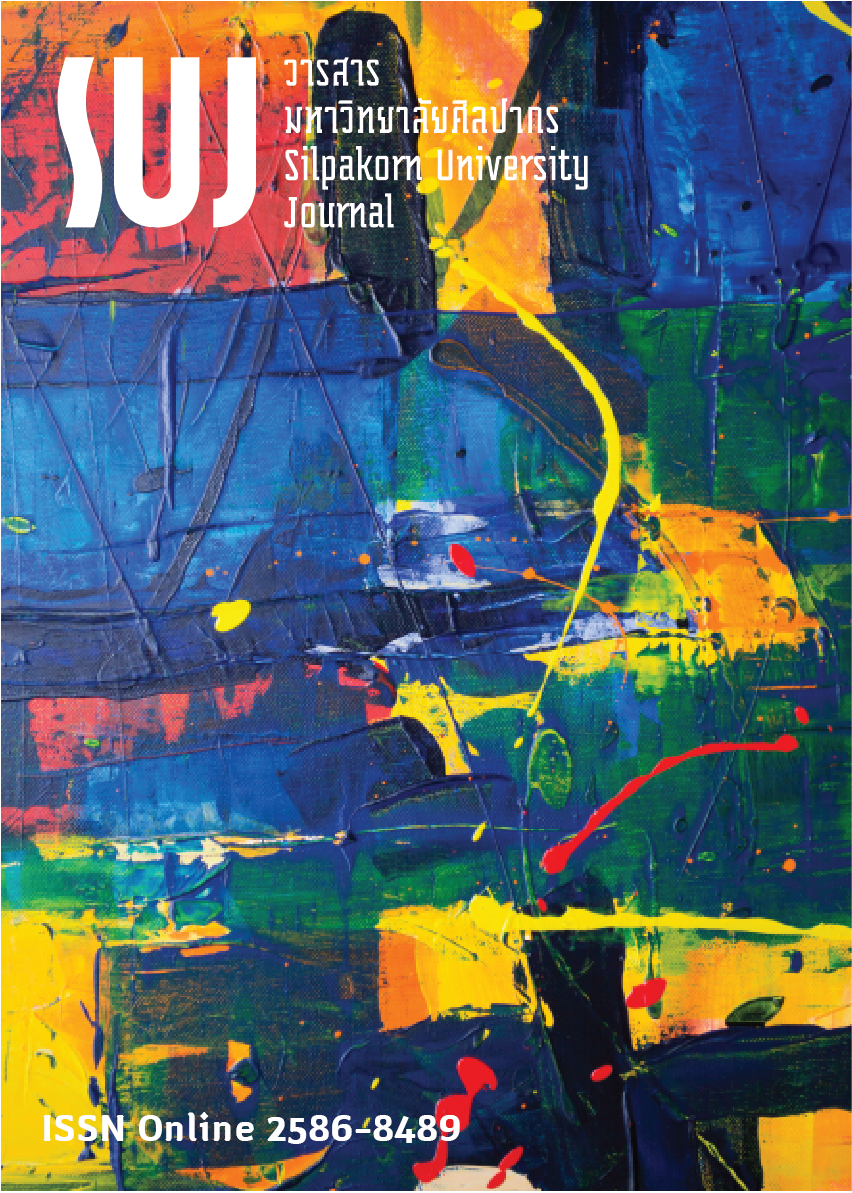การพัฒนาตัวบ่งชี้และแบบวัดการส่งเสริมโภชนาการสำหรับเยาวชนภาคตะวันออกของประเทศไทย (The development of indicators and a scale of nutrition promotion for the youths in the eastern region of Thailand)
Main Article Content
Abstract
การวิจัยมีวัตถุประสงค์เพื่อ 1) พัฒนาตัวบ่งชี้การส่งเสริมโภชนาการสำหรับเยาวชนในภาคตะวันออกของประเทศไทย 2) พัฒนาแบบวัดการส่งเสริมโภชนาการสำหรับเยาวชนในภาคตะวันออกของประเทศไทย 3) ตรวจสอบความสอดคล้องของโมเดลการวัดที่พัฒนาขึ้นกับข้อมูลเชิงประจักษ์ กลุ่มตัวอย่างเป็นเยาวชนอายุ 19-25 ปีในภาคตะวันออก จำนวน 800 คน วิเคราะห์ข้อมูลด้วยการวิเคราะห์เอกสาร การวิเคราะห์องค์ประกอบเชิงสำรวจ การวิเคราะห์องค์ประกอบเชิงยืนยันอันดับที่ 1-2 โดยใช้โปรแกรม LISREL และการสัมภาษณ์ผู้ทรงคุณวุฒิ จำนวน 50 คน
ผลการวิจัยพบว่า 1) ตัวบ่งชี้หลักของการส่งเสริมโภชนาการสำหรับเยาวชนในภาคตะวันออกของประเทศไทยอย่างมีนัยสำคัญทางสถิติที่ระดับ .01 โดยเรียงลำดับจากน้อยไปมาก มี 4 ตัวบ่งชี้หลัก เรียกว่า PANE ได้แก่ 1.1) ด้านการรับรู้ทางโภชนาการ (Perception) 1.2) ด้านกิจกรรมการบริโภคในชีวิตประจำวัน (Activity) 1.3) ด้านงดการบริโภคเครื่องดื่มแอลกอฮอล์และจำกัดการเข้าถึงเครื่องดื่มแอลกอฮอล์ (No alcohol) 1.4) ด้านการสนับสนุนจากภาครัฐ สถานประกอบการ สถาบันการศึกษาและบุคคล (Encouragement) 2) แบบวัดการส่งเสริมโภชนาการสำหรับเยาวชนภาคตะวันออกของประเทศไทยมี 4 ตัวบ่งชี้หลัก (PANE) และ 20 ตัวบ่งชี้ย่อย ได้แก่ 2.1) ด้านการรับรู้ทางโภชนาการ (Perception) มี 4 ตัวบ่งชี้ย่อย 2.2) ด้านกิจกรรมการบริโภคในชีวิตประจำวัน (Activity) มี 8 ตัวบ่งชี้ย่อย 2.3) ด้านงดการบริโภคเครื่องดื่มแอลกอฮอล์และจำกัดการเข้าถึงเครื่องดื่มแอลกอฮอล์ (No alcohol) มี 2 ตัวบ่งชี้ย่อย 2.4) ด้านการสนับสนุนจากภาครัฐ สถานประกอบการ สถาบันการศึกษาและบุคคล (Encouragement) มี 6 ตัวบ่งชี้ย่อย 3) โมเดลการวัดการส่งเสริมโภชนาการสำหรับเยาวชนภาคตะวันออกของประเทศไทยที่ผู้วิจัยพัฒนาขึ้นมีความสอดคล้องกับข้อมูลเชิงประจักษ์ (X2 = 4.94, df = 47.00, P-value = 1.00, GFI = 1.00, AGFI = 0.99, RMR = 0.0081, RMSEA = 0.000) การศึกษานี้เสนอแนะว่า ตัวบ่งชี้การส่งเสริมโภชนาการสำหรับเยาวชนในภาคตะวันออกของประเทศไทยที่สำคัญที่สุดคือ ตัวบ่งชี้หลักด้านการสนับสนุนจากภาครัฐ สถานประกอบการ สถาบันการศึกษาและบุคคล (Encouragement) มี 6 ตัวบ่งชี้ย่อย เรียกว่า GUARDS ได้แก่ การสนับสนุนด้านการรับประทานผัก ผลไม้ (Green) การสนับสนุนด้านการรับประทานข้าวกล้อง (Unpolished rice) การสนับสนุนด้านการรับประทานที่มีประโยชน์ (Advantage) การสนับสนุนด้านการลดเกลือ ลดการบริโภคไขมันทรานส์ ลดความอ้วน (Reduction) การสนับสนุนด้านการเลือกร้านประกอบการอาหารเพื่อสุขภาพ (Diner) การสนับสนุนด้านงดการดื่มเครื่องดื่มแอลกอฮอล์และรณรงค์เกี่ยวกับนโยบายที่เกี่ยวข้อง (Stop of alcohol)
The purposes of this research were to 1) develop the indicators of nutrition promotion for the youths in the eastern region of Thailand, 2) develop a scale of nutrition promotion for the youths in the eastern region of Thailand, and 3) test the goodness of fit between the developed measurement model and the empirical data. The sample were 800 youths between 19-25 years of age in the eastern region of Thailand. The data were analyzed by documents, exploratory factor analysis, first-second order confirmatory factor analysis by using LISREL, and interviews of 50 experts.
The findings were as follows: 1) the main indicators that most significantly related to nutrition promotion for the youths in the eastern region of Thailand comprised 4 main indicators, or the so-called PANE concept: 1.1) Perception of nutrition (Perception), 1.2) Activity about nutrition in daily life (Activity), 1.3) No alcohol and restricted access to alcohol (No alcohol), 1.4) encouragement from the government, working places, educational institutions, and the person (Encouragement). 2) A scale of nutrition promotion for the youths in the eastern region of Thailand comprised 4 main indicators (PANE) and 20 minor indicators: 2.1) Perception of nutrition (Perception) comprised 4 minor indicators, 2.2) Activity about nutrition in daily life (Activity) comprised 8 minor indicators, 2.3) No alcohol and restricted access to alcohol (No alcohol) comprised 2 minor indicators, and 2.4) Encouragement from the government, working places, educational institutions, and the person (Encouragement) comprised 6 minor indicators. 3) A scale model of nutrition promotion for the youths in the eastern region of Thailand which the researcher had developed the theory from the empirical data were in accordance with the data (X2 = 4.94, df = 47.00, P-value = 1.00, GFI = 1.00, AGFI = 0.99, RMR = 0.0081, RMSEA = 0.000). This study suggested that the best indicators of nutrition promotion for the youths in the eastern region of Thailand was encouragement from the government, working places, educational institutions, and the public (Encouragement) comprised 6 minor indicators, or the so-called GUARDS concept, which are green eating or fruit and vegetable consumption in daily life (Green), unpolished rice consumption (Unpolished rice), advantage food (Advantage), reduction of salt consumption, trans-fat reduction and fat reduction (Reduction), diner for health (Diner), and stop of alcohol and relevant policy (Stop of alcohol).
Downloads
Article Details
References
Health Promotion Policy Research Center International Health Policy Program. (2014). Status Report on NCDs, Health crisis, Social crisis (รายงานสถานการณ์โรค NCDs วิกฤตสุขภาพ วิกฤตสังคม). Nonthaburi: Health Promotion Policy Research Center International Health Policy Program.
Krejcie, R. V. & Morgan, D. W. (1970). Determining sample size for research activities. Journal of Educational and Psychological Measurement, 30(3): 607-610.
Leger, L. St. (1999). The opportunities and effectiveness of the health promoting primary school in improving child health a review of the claims and evidence. Journal of Health Education Research Theory & Practice, 14(1): 51-69.
Ministry of Public Health. (2011). Public Health of Thailand 2008-2010 (การสาธารณสุขไทย 2551-2553). Nonthaburi: Ministry of Public Health.
National Statistical Office. (2017). Per Capita Income of Population by Region and Province: 2005-2014 (รายได้เฉลี่ยต่อหัวของประชากร จำแนกตามภาคและจังหวัด พ.ศ. 2548 - 2557). [Online].Retrieved January 27, 2017 from http://service.nso.go.th/nso/web/statseries/statseries15.html
Niampradit, Phajongsook. (2012). Development of Health Promotion Activities Model for University Students in the Eastern region of Thailand (การพัฒนารูปแบบกิจกรรมการส่งเสริมสุขภาพสำหรับนิสิตมหาวิทยาลัยในภาคตะวันออก). Doctoral’s dissertation, Burapha University, Chon Buri, Thailand.
Office of the Permanent Secretary for Public Health. (2017). Number of Deaths by Leading Cause of Death, Whole Kingdom: 2017 (จำนวนการตายจำแนกตามสาเหตุการตายทั่วราชอาณาจักร พ.ศ. 2560). [Online]. Retrieved February 2, 2019 from http://bps.moph.go.th/new_bps/sites/default/files/stratistics60.pdf
World Health Organization. (2010). Global Status Report on Noncommunicable Diseases 2010. Geneva: WHO.
World Health Organization. (2014). Global Status Report on Noncommunicable Diseases 2014. Geneva: WHO.


